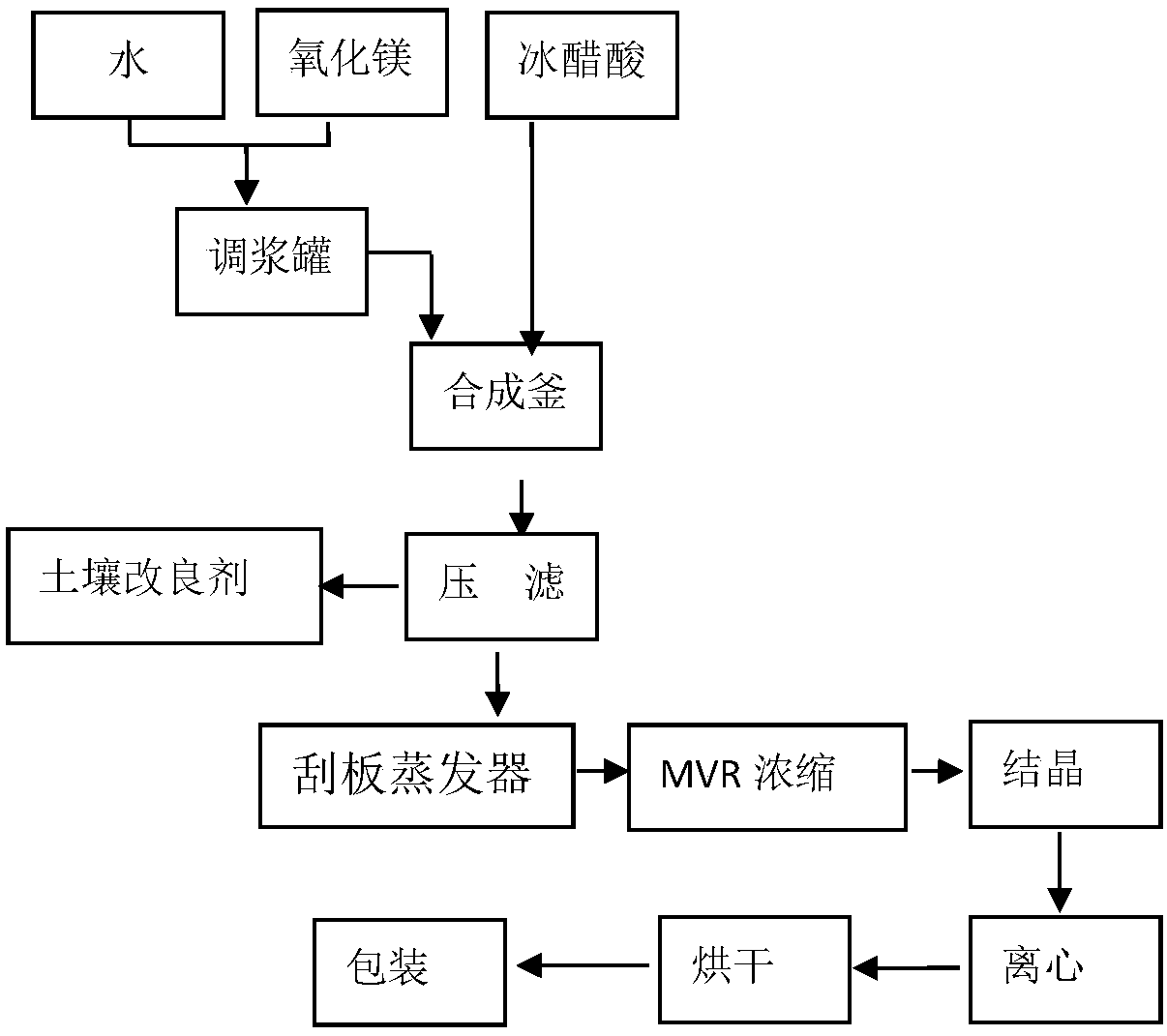Magnesium acetate tetrahydrate and its preparation process and application
A preparation process, the technology of magnesium acetate, applied in the field of magnesium acetate tetrahydrate preparation, can solve the problems of high application cost and influence on promotion and application, and achieve the effect of low application cost, easy degradation, and good effect of market promotion and application
- Summary
- Abstract
- Description
- Claims
- Application Information
AI Technical Summary
Problems solved by technology
Method used
Image
Examples
Embodiment 1
[0039] (1) Synthesis: In a slurry tank filled with an appropriate amount of water, 390 kg of powdery light-burned magnesium oxide is dropped into, and stirred evenly. Then the slurry and 794kg of glacial acetic acid are dropped into the synthesis kettle, and the stirring is started. Among them: the molar ratio of light-burned magnesia and glacial acetic acid is 1:1.9. The content of magnesium oxide is 80%, and the content of glacial acetic acid is 98%.
[0040] (2) Reaction: After the feeding is completed, the reaction is exothermic, and the reaction temperature is maintained at 80-90° C., and the temperature is kept for 2-3 hours. The control reaction end point is that the pH value is between 6-7, and the Baume degree is between 15-16°Bé.
[0041] (3) Pressure filtration: filter the reacted feed liquid through a plate and frame filter press to obtain a filtrate. The filter residue obtained after pressure filtration is used to prepare soil conditioner.
[0042] (4) Scraper...
Embodiment 2
[0049] (1) Synthesis: Add 405Kg of powdery light-burned magnesium oxide to a slurry tank filled with an appropriate amount of water, and stir evenly. Then the slurry and 868kg of glacial acetic acid are dropped into the synthesis kettle, and the stirring is started. Among them: the molar ratio of light-burned magnesia and glacial acetic acid is 1:2. The content of magnesium oxide is 80%, and the content of glacial acetic acid is 98%.
[0050] (2) Controlling the reaction: After the feeding is completed, the reaction is exothermic, and the reaction temperature is kept at 80-90° C., and the temperature is kept for 2-3 hours. The control reaction end point is that the pH value is between 6-7, and the Baume degree is between 15-16°Bé.
[0051] (3) Pressure filtration: filter the reacted feed liquid through a plate and frame filter press to obtain a filtrate. The filter residue obtained after pressure filtration is used to prepare soil conditioner.
[0052] (4) Scraper evaporat...
Embodiment 3
[0059] (1) Synthesis: In a slurry tank filled with an appropriate amount of water, put 440 kg of powdery light-burned magnesium oxide into it, and stir evenly. Then the slurry and 990kg of glacial acetic acid are dropped into the synthesis kettle, and the stirring is started. Among them: the molar ratio of light-burned magnesia and glacial acetic acid is 1:2.1. The content of magnesium oxide is 80%, and the content of glacial acetic acid is 98%.
[0060] (2) Controlling the reaction: After the feeding is completed, the reaction is exothermic, and the reaction temperature is kept at 80-90° C., and the temperature is kept for 2-3 hours. The control reaction end point is that the pH value is between 6-7, and the Baume degree is between 15-16°Bé.
[0061] (3) Pressure filtration: filter the reacted feed liquid through a plate and frame filter press to obtain a filtrate. The filter residue obtained after pressure filtration is used to prepare soil conditioner.
[0062] (4) Scra...
PUM
| Property | Measurement | Unit |
|---|---|---|
| melting point | aaaaa | aaaaa |
Abstract
Description
Claims
Application Information
 Login to View More
Login to View More - R&D
- Intellectual Property
- Life Sciences
- Materials
- Tech Scout
- Unparalleled Data Quality
- Higher Quality Content
- 60% Fewer Hallucinations
Browse by: Latest US Patents, China's latest patents, Technical Efficacy Thesaurus, Application Domain, Technology Topic, Popular Technical Reports.
© 2025 PatSnap. All rights reserved.Legal|Privacy policy|Modern Slavery Act Transparency Statement|Sitemap|About US| Contact US: help@patsnap.com


